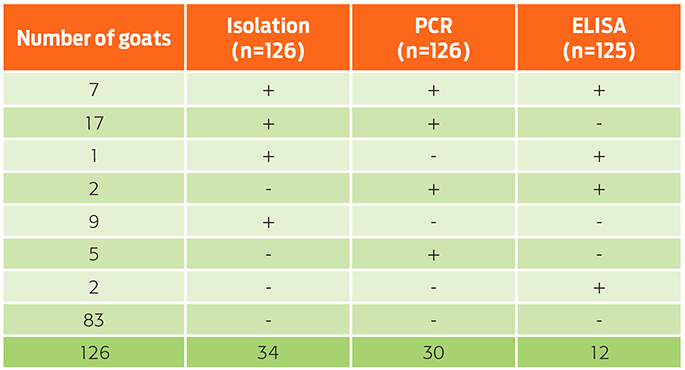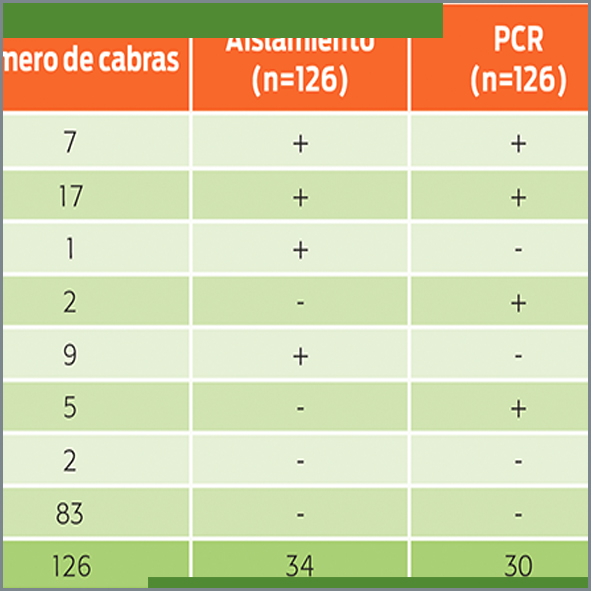Isolation of <em>Chlamydia abortus</em> in dairy goat herds and its relation to abortion in Guanajuato, Mexico
Main Article Content
Abstract
Veterinaria México OA
ISSN: 2448-6760
Cite this as:
- Mora-Díaz JC, Díaz-Aparicio E, Herrera-López E, Suárez-Güemez F, Escalante-Ochoa C, Jaimes-Villareal S, et al. Isolation of Chlamydia abortus in dairy goat herds and its relation to abortion in Guanajuato, Mexico. Veterinaria México OA. 2015;2(1).doi: 10.21753/vmoa.2.1.339.
Although Chlamydia abortus is classified as an exotic agent in Mexico, there is increasing evidence of its presence. The objective of this study was to isolate C. abortus in dairy goat herds with problems of abortion in the state of Guanajuato, Mexico, and to develop appropriate diagnostic methods for its detection. Serological samples and vaginal swabs were taken from 6 dairy goat herds. The ELISA revealed a seropositivity of 9.60% for C. abortus. The PCR test based on the vaginal mucus samples resulted in 30 of 126 positive animals (23.8%). Chlamydia spp. were isolated in 34 of the 126 animals tested (26.98%). The 3 diagnostic methods tested were valuable and complementary in zones where Chlamydia is suspected to cause abortions. We demonstrated that the bacteria are present in dairy goat herds of Mexico; thus, Veterinary Sanitary Authorities should consider this disease endemic to establish sanitary procedures to control the spread of the disease and to prevent human transmission.

Article Details
References
1) Aguilar RF, Arellano RB, Bibriesca RE, Diaz AE et al. 2011. Estudio epidemiológico de las principales enfermedades bacterianas que afectan a los caprinos en México. Resultados preliminares. XXVI Reunión Nacional Sobre Caprinocultura Querétaro, México, 5-8 octubre. Juriquilla: Facultad de Ciencias Naturales, Universidad Autónoma de Querétaro.
2) Andersen AA. 1991. Serotyping of Chlamydia psittaci isolates using serovar-specific monoclonal antibodies with the microimmunofluorescence test. Journal of Clinical Microbiology 29:707-711.
3) Armijo R. 1994. Epidemiología básica en atención primaria de la salud. Spain: Ediciones Díaz de Santos.
4) Barbosa Mireles M, Salazar García F, Fernández Rosas P, Montes de Oca R. 2013. Detección de anticuerpos serológicos contra Chlamydophila abortus en dos grupos de personas expuestas a riesgo en explotaciones ovinas en Xalatlaco, México. Tropical and Subtropical Agroecosystems 16:483-486.
5) Biberstein LE, Hirsh CD. 2004. Chlamydiae. In: Hirch CD, Maclachlan NJ, Walter LR. (editors) Veterinary Microbiology. 2nd ed. USA: Blackwell Publishing.
6) Campos-Hernandez E, Vazquez-Chagoyan C, Salem AZ, Saltijeral-Oaxaca JA, Escalante-Ochoa C, Lopez-Heydeck SM, De Oca-Jimenez RM. 2014. Prevalence and molecular identification of Chlamydia abortus in commercial dairy goat farms in a hot region in Mexico. Tropical Animal Health and Production. 46:919-924.
7) Chisu V, Porcu R, Tanda A, Masala G. 2013. First isolation and characterization of Chlamydophila abortus from abortion tissues of sheep in Sardinia, Italy. Veterinaria Italiana 49(4):331-4.
8) Cohen J. 1960. A coefficient of agreement for nominal scales. Educational and Psychological Measurement 20:37-46.
9) Escalante-Ochoa C, Diaz-Aparicio E, Segundo-Zaragoza C, Suarez-Guemes F. 1997. Isolation of Chlamydia psittaci involved in abortion of goats in Mexico: first report. Revista Latinoamericana de Microbiología 39:117-121.
10) Escalante-Ochoa C, Rivera-Flores, A, Trigo-Tavera F, Romero-Martinez J. 1996. Detection of Chlamydia psittaci in enteric subclinical infections in adult sheep, through cell culture isolation. Revista Latinoamericana de Microbiología 38:17-23.
11) Escalante OC, Lazcano C, Soberón A. 2001. Chlamydophila spp. como agente zoonótico en México (Chlamydophila spp as a zoonotic agent in Mexico). XXXVIII Reunión Nacional de Investigación Pecuaria. Tuxtla Gutiérrez, Chiapas, México.
12) Everett KD, Bush RM, Andersen AA. 1999. Emended description of the order Chlamydiales, proposal of Parachlamydiaceae fam. nov. and Simkaniaceae fam. nov., each containing one monotypic genus, revised taxonomy of the family Chlamydiaceae, including a new genus and five new species, and standards for the identification of organisms. International Journal of Systematic Bacteriology 49:415-440.
13) Greenberg SR, Flanders DW, Daniels SR, Eley JW. 2002. Epidemiología médica. México: El Manual Moderno.
14) Gutierrez J, Williams EJ, O’Donovan J, Brady C, Proctor AF, Marques PX, Worrall S, Nally JE, Mcelroy M, Bassett HF, Sammin DJ, Markey BK. 2011. Monitoring clinical outcomes, pathological changes and shedding of Chlamydophila abortus following experimental challenge of periparturient ewes utilizing the natural route of infection. Veterinary Microbiology 147:119-26.
15) Kuo CC, Stephens RS, Bavoil PM, Kaltenboeck B. 2011. Genus Chlamydia. In: Krieg NR, Staley JT, Brown DR, Hedlund BP, Paster BJ, Ward NL, Ludwig W, Whitman WB. (editors) Bergey’s manual of systematic bacteriology. Volume 5: the actinobacteria, part A. 2nd ed. New York, Springer: Heidelberg.
16) Landis J, Koch G. 1977. The measurement of observer agreement for categorical data. Biometrics 33:159-174.
17) Lazcano AC. 2006. Detección de Chlamydophila spp. en rebaños caprinos del estado de Michoacán mediante técnica inmunodiagnóstica ELISA y aislamiento bacteriológico [tesis de licenciatura]. DF, México: FMVZ-UNAM.
18) Lazcano AC, Escalante OC, Ducöing WA, Trejo A. 2005. Inmunodetección de Chlamydophila abortus en caprinos de Ecuandureo, Michoacán, México, mediante prueba de ELISA. XLI Reunión Nacional de Investigación Pecuaria, 14-18 Noviembrre. Cuernavaca, Morelos, México: INIFAP, SAGARPA.
19) Longbottom D, Coulter LJ. 2003. Animal chlamydioses and zoonotic implications. Journal of Comparative Pathology 128:217-44.
20) Mora DJC. 2011. Determinación de Chlamydophila abortus en rebaños caprinos lecheros de Guanajuato, México, con casos de aborto sugerentes de clamidiosis [tesis de licenciatura]. DF, México: FMVZ-UNAM.
21) Mora-Díaz JC, Escalante-Ochoa C, Diaz-Aparicio E, Jaimes MS, Martínez G, Trujillo AB. 2008. Determinación serológica de Chlamydophila abortus en ganado caprino lechero en México. XXI Congreso Panamericano de Ciencias Veterinarias. Guadalajara, Jalisco, México.
22) Mora-Díaz JC, Escalante-Ochoa C, Diaz-Aparicio E, Jaimes MS, Martínez G, Trujillo AB. 2009. Chlamydophila abortus serological determination in dairy goats in Mexico: preliminary advances. Caro MR, Salinas J, Buendía AJ (editors) First European Meeting on Animal Chlamydioses and Zoonotic Aspects. Murcia, Spain.
23) Rodolakis A. 2001. Caprine Chlamydiosis In: Tempestra M. (editor). Recent Advances in Goat Diseases. Ithaca, NY: International Veterinary Information Service (IVIS). http://www.ivis.org/advances/Disease_Tempesta/rodolakis_chlamydiosis/IVIS.pdf [accessed: 26 Nov 2014].
24) Sachse K, Vretou E, Livingstone M, Borel N, Pospischil A, Longbotton D. 2009. Recent developments in the laboratory diagnosis of chlamydial infections. Veterinary Microbiology 135:2-21.
25) SAGARPA. 20 de septiembre de 2007. Acuerdo mediante el cual se enlistan las enfermedades y plagas de los animales, exóticas y endémicas de notificación obligatoria en los Estados Unidos Mexicanos. México: Diario Oficial de la Federación.
26) Sambrook J, Russell D. 2001. Molecular cloning a laboratory manual. USA: CSHC Press.
27) Vanrompay D, Van Nerom A, Ducatelle R, Haesebrouck F. 1994. Evaluation of five immunoassays for detection of Chlamydia psittaci in cloacal and conjunctival specimens from turkeys. Journal of Clinical Microbiology 32:1470-4.
License

Veterinaria México OA by Facultad de Medicina Veterinaria y Zootecnia - Universidad Nacional Autónoma de México is licensed under a Creative Commons Attribution 4.0 International Licence.
Based on a work at http://www.revistas.unam.mx
- All articles in Veterinaria México OA re published under the Creative Commons Attribution 4.0 Unported (CC-BY 4.0). With this license, authors retain copyright but allow any user to share, copy, distribute, transmit, adapt and make commercial use of the work, without needing to provide additional permission as long as appropriate attribution is made to the original author or source.
- By using this license, all Veterinaria México OAarticles meet or exceed all funder and institutional requirements for being considered Open Access.
- Authors cannot use copyrighted material within their article unless that material has also been made available under a similarly liberal license.



